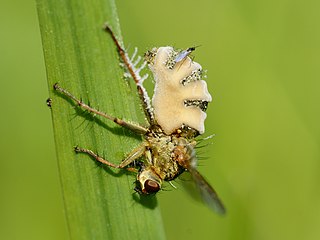The Paul R. Halmos – Lester R. Ford Award is a $1,000 prize given annually by the Mathematical Association of America for authors of articles of expository excellence published in The American Mathematical Monthly or Mathematics Magazine. It is awarded to at most four authors each year. The prize was established in 1964 as the Lester R. Ford Award to honor the contributions of mathematician and former MAA president Lester R. Ford. In 2012 the award was renamed the Paul R. Halmos – Lester R. Ford Award to honor the contributions of former The American Mathematical Monthly editor Paul R. Halmos and the support of the Halmos family for the awards. Halmos himself received the award in 1971 and 1977.

The Entomophthorales are an order of fungi that were previously classified in the class Zygomycetes. A new subdivision, Entomophthoromycotina, in 2007, was circumscribed for them.

Entomophthora is a fungal genus in the family Entomophthoraceae. Species in this genus are parasitic on flies and other two-winged insects. The genus was circumscribed by German physician Johann Baptist Georg Wolfgang Fresenius (1808–1866) in 1856.

Conidiobolus is a genus of fungi in order Entomophthorales. Some species were defined in Conidiobolus but then moved into other genera such as Capillidium and Batkoa.

Job Bicknell Ellis was a pioneering North American mycologist known for his study of ascomycetes, especially the grouping of fungi called the Pyrenomycetes. Born and raised in New York, he worked as a teacher and farmer before developing an interest in mycology. He collected specimens extensively, and together with his wife, prepared 200,000 sets of dried fungal samples that were sent out to subscribers in series between 1878 and 1894. Together with colleagues William A. Kellerman and Benjamin Matlack Everhart, he founded the Journal of Mycology in 1885, forerunner to the modern journal Mycologia. He described over 4000 species of fungi, and his collection of over 100,000 specimens is currently housed at the herbarium of the New York Botanical Gardens. Ellis had over 100 taxa of fungi named in his honor.

Sporothrix is a ubiquitous genus of soil-dwelling fungus discovered by Schenck in 1898, and studied in more detail by Hektoen and Perkins. The first described and best known species is Sporothrix schenckii, the causative agent of rose handler's disease. New environmental, and pathogenic, species have been discovered with the potential for more to be found as molecular techniques advance.

Entomophaga is a genus of entomopathogenic fungi in the Entomophthoraceae family and also the order Entomophthorales. This has been supported by molecular phylogenetic analysis.

Entomophthoromycota is a division of kingdom fungi. In 2007, it was placed at the taxonomic rank of subphylum in the most recent revision of the entire fungus kingdom. In 2012, it was raised to the rank of phylum as "Entomophthoromycota" in a scientific paper by Richard A. Humber 2012. Divided into three classes and six families, it contains over 250 species that are mostly arthropod pathogens or soil- and litter-borne saprobes.

Pandora is a genus of fungi within the order Entomophthorales. This has been supported by molecular phylogenetic analysis.
Zoophthora is a genus of fungi in the family Entomophthoraceae. Like other taxa in this family, Zoophthora species cause disease in insects and as such are considered entomopathogenic fungi.

Entomophthoraceae is a family of fungi in the order Entomophthorales. This has been supported by molecular phylogenetic analysis. Most species in the family are obligately entomopathogenic. There are two subfamilies, Erynioideae and Entomophthoroideae, which were proposed in 2005.
Donald W. Roberts was an American insect pathologist and one of the originators of that field. He was especially known for research into biological pest control of Lepidoptera by Metarhizium but also Beauveria bassiana. He was a Research Professor Emeritus in the Biology Department of Utah State University.
Strongwellsea is a genus of fungi within the order Entomophthorales of the Zygomycota. They are known to infect insects. Infected adult dipteran hosts develop a large hole in their abdomens, through which conidia (spores) are then actively discharged while the hosts are still alive.
Tarichium is a genus of fungi within the order Entomophthorales of the Zygomycota. This has been supported by molecular phylogenetic analysis.

Furia is a genus of fungi within the family of Entomophthoraceae. This has been supported by molecular phylogenetic analysis.
Batkoa is a genus of fungi within the family of Entomophthoraceae and order Entomophthorales of the Zygomycota. This has been supported by molecular phylogenetic analysis.
Eryniopsis is a genus of fungi within the family of Entomophthoraceae and order Entomophthorales. This has been supported by molecular phylogenetic analysis.







